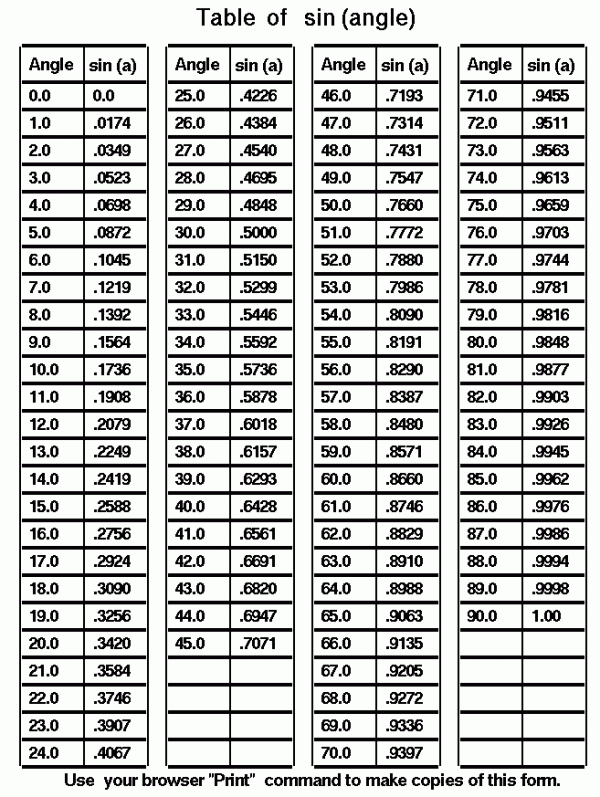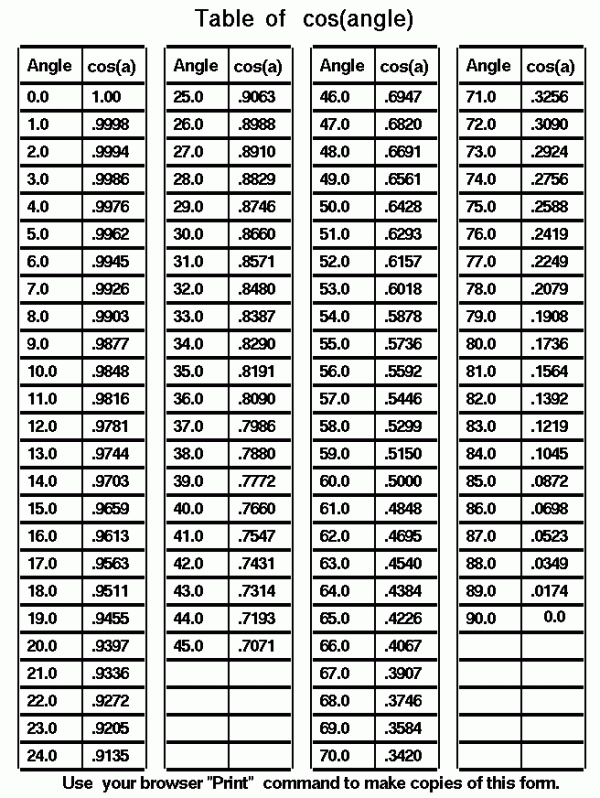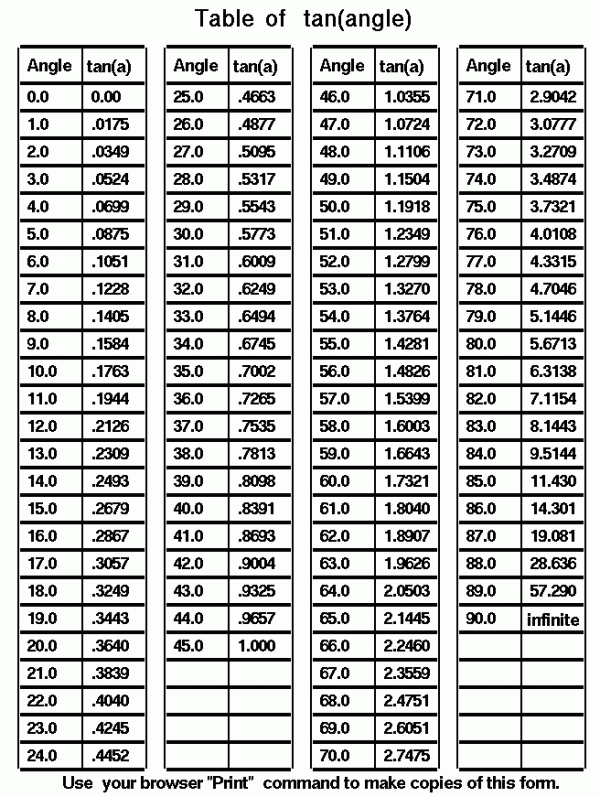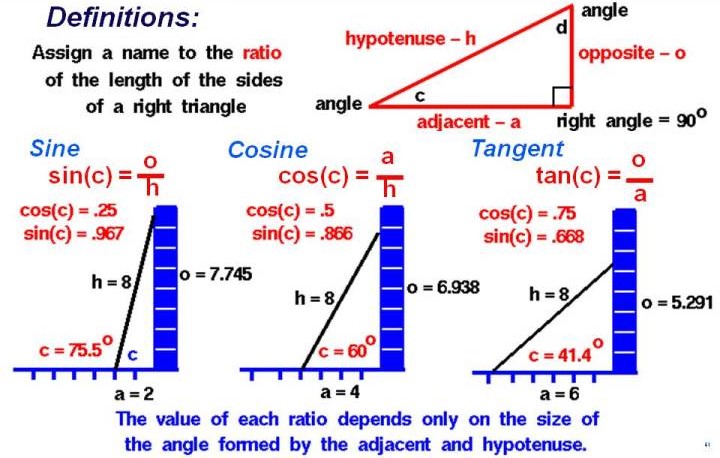Sine-Cosine-Tangent
To better understand what the Wright Brothers accomplished and how they did it, it is necessary to use some mathematical ideas from trigonometry, the study of triangles. Most people are introduced to trigonometry in high school, but for the elementary and middle school students, or the mathematically-challenged:
DON’T PANIC!
There are many complex parts to trigonometry and we aren’t going there. We are going to limit ourselves to the very basics which are used in the study of airplanes. If you understand the idea of ratios, one variable divided by another variable, you should be able to understand this page. It contains nothing more than definitions. The words are a bit strange, but the ideas are very powerful as you will see.
Let us begin with some definitions and terminology which we use on this slide. A right triangle is a three sided figure with one angle equal to 90 degrees. A 90 degree angle is called a right angle which gives the right triangle its name. We pick one of the two remaining angles and label it c and the third angle we label d. The sum of the angles of any triangle is equal to 180 degrees. If we know the value of c, we then know that the value of d:
90 + c + d = 180
d = 180 – 90 – c
d = 90 – c
We define the side of the triangle opposite from the right angle to be the hypotenuse. It is the longest side of the three sides of the right triangle. The word “hypotenuse” comes from the Greek words for “side” and “to stretch”, since this is the longest side. We label the hypotenuse with the symbol h. There is a side opposite the angle c which we label o for “opposite”. The remaining side we label a for “adjacent”. The angle c is formed by the intersection of the hypotenuse h and the adjacent side a.
We are interested in the relations between the sides and the angles of the right triangle. While the length of any one side of a right triangle is completely arbitrary, the ratio of the sides of a right triangle depend only on the value of the angle “c”. We illustrate this fact at the bottom of this page.
Let us start with some definitions. We will call the ratio of the opposite side of a right triangle to the hypotenuse the sine and give it the symbol sin.
sin(c) = o / h
The ratio of the adjacent side of a right triangle to the hypotenuse is called the cosine and given the symbol cos.
cos(c) = a / h
Finally, the ratio of the opposite side to the adjacent side is called the tangent and given the symbol tan.
tan(c) = o / a
We claim that the value of each ratio depends only on the value of the angle c formed by the adjacent and the hypotenuse. To demonstrate this fact, let’s study the three figures in the middle of the page. In this example, we have an 8 foot ladder that we are going to lean against a wall. The wall is 8 feet high, and we have drawn white lines on the wall and blue lines along the ground at one foot intervals. The length of the ladder is fixed. If we incline the ladder so that its base is 2 feet from the wall, the ladder forms an angle of nearly 75.5 degrees degrees with the ground. The ladder, ground, and wall form a right triangle. The ratio of the distance from the wall (a – adjacent), to the length of the ladder (h – hypotenuse), is 2/8 = .25. This is defined to be the cosine of c = 75.5 degrees. (On another page we will show that if the ladder was twice as long (16 feet), and inclined at the same angle(75.5 degrees), that it would sit twice as far (4 feet) from the wall. The ratio stays the same for any right triangle with a 75.5 degree angle.) If we measure the spot on the wall where the ladder touches (o – opposite), the distance is 7.745 feet. You can check this distance by using the Pythagorean Theorem that relates the sides of a right triangle:
h^2 = a^2 + o^2
o^2 = h^2 – a^2
o^2 = 8^2 – 2^2
o^2 = 64 – 4 = 60
o = 7.745
The ratio of the opposite to the hypotenuse is .967 and defined to be the sine of the angle c = 75.5 degrees.
Now suppose we incline the 8 foot ladder so that its base is 4 feet from the wall. As shown on the figure, the ladder is now inclined at a lower angle than in the first example. The angle is 60 degrees, and the ratio of the adjacent to the hypotenuse is now 4/8 = .5 . Decreasing the angle c increases the cosine of the angle because the hypotenuse is fixed and the adjacent increases as the angle decreases. If we incline the 8 foot ladder so that its base is 6 feet from the wall, the angle decreases to about 41.4 degrees and the ratio increases to 6/8, which is .75. As you can see, for every angle, there is a unique point on the ground that the 8 foot ladder touches, and it is the same point every time we set the ladder to that angle. Mathematicians call this situation a function. The ratio of the adjacent side to the hypotenuse is a function of the angle c, so we can write the symbol as cos(c) = value.
Notice also that as the cos(c) increases, the sin(c) decreases. If we incline the ladder so that the base is 6.938 feet from the wall, the angle c becomes 30 degrees and the ratio of the adjacent to the hypotenuse is .866. Comparing this result with example two we find that:
cos(c = 60 degrees) = sin (c = 30 degrees)
sin(c = 60 degrees) = cos (c = 30 degrees)
We can generalize this relationship:
sin(c) = cos (90 – c)
90 – c is the magnitude of angle d. That is why we call the ratio of the adjacent and the hypotenuse the “co-sine” of the angle.
sin(c) = cos (d)
Since the sine, cosine, and tangent are all functions of the angle “c”, we can determine (measure) the ratios once and produce tables of the values of the sine, cosine, and tangent for various values of “c”. Later, if we know the value of an angle in a right triangle, the tables tells us the ratio of the sides of the triangle. If we know the length of any one side, we can solve for the length of the other sides. Or if we know the ratio of any two sides of a right triangle, we can find the value of the angle between the sides. We can use the tables to solve problems. Some examples of problems involving triangles and angles include the descent of a glider, the torque on a hinge, the operation of the Wright brothers’ lift and drag balances, and determining the lift to drag ratio for an aircraft.
Here are tables of the sine, cosine, and tangent which you can use to solve problems.
Table of sin(a)

Table of cos(a)

Table of tan(a)


